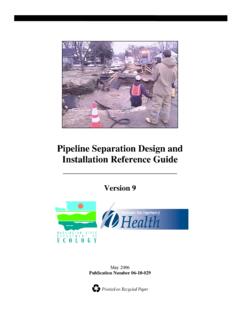Transcription of Chapter 1 - Carbon Adsorbers
1 Chapter 1 Carbon Adsorbers John L. Sorrels Air Economics Group Health and Environmental Impacts Division Office of Air Quality Planning and Standards Environmental Protection Agency Research Triangle Park, NC 27711 Amanda Baynham, David D. Randall, Karen S. Schaffner RTI International Research Triangle Park, NC 27709 October 2018 DISCLAIMER This document includes references to specific companies, trade names and commercial products. Mention of these companies and their products in this document is not intended to constitute an endorsement or recommendation by the Environmental Protection Agency.
2 I Contents Chapter 1 Carbon Adsorbers Introduction .. 1-1 Types of Adsorbers .. 1-2 Fixed-bed Units .. 1-2 Canister 1-3 Moving-Bed Adsorbers .. 1-4 Fluid-Bed Adsorbers .. 1-5 Types of Adsorbent .. 1-5 Adsorbent 1-10 Adsorption Theory .. 1-11 Design Procedure .. 1-15 Sizing 1-15 Determining Adsorption and Desorption Times .. 1-17 Estimating Carbon Requirement .. 1-18 Estimating Total Capital Investment .. 1-20 Fixed-Bed Systems .. 1-20 Canister Systems .. 1-25 Estimating Total Annual Cost .. 1-27 Direct Annual Costs .. 1-27 Indirect Annual Costs.
3 1-32 Recovery Credits and Disposal Costs .. 1-33 Total Annual Cost .. 1-34 Cost Effectiveness .. 1-34 Example Problem .. 1-34 Design Parameter Example .. 1-35 Cost Estimate Example .. 1-37 Total Annual Costs .. 1-39 Acknowledgements .. 1-45 References .. 1-45 ii List of Figures Figure : Typical-Two-Bed, Continuously Operated Fixed Bed Carbon Adsorber System .. 1-3 Figure : Schematic of a Fluid-Bed Adsorber .. 1-5 Figure : Effects of Humidity on Adsorption Capacity of Activated Carbon and Zeolite .. 1-7 Figure : Effects of Humidity on Adsorption Capacity of Activated Carbon and Dowex OptiporeTM V493 Polymer.
4 1-8 Figure : Type 1 Adsorption Isotherms for Hypothetical Adsorbate .. 1-12 List of Tables Table : Comparison of Activated Carbon , Zeolite and Polymer Adsorbents .. 1-9 Table : Parameters for Selected Adsorption Isotherms .. 1-13 Table : Adjustment Factors to Obtain Costs for Fabricated Material .. 1-23 Table : Capital Cost Factors for Carbon Adsorbers .. 1-25 Table : Equipment Costs for Typical Canister Adsorbers .. 1-26 Table : Equipment Costs for Typical Large Canister Adsorbers .. 1-26 Table : Estimated Total Capital Cost for the Carbon Adsorber .. 1-38 Table : Estimated Annual Costs for the Carbon Adsorber.
5 1-44 1-1 Introduction Adsorption is a non-destructive control technology employed to remove volatile organic compounds (VOCs) from low to medium concentration gas streams. Adsorption is generally used when a stringent outlet concentration must be met and/or recovery of the VOC is desired. Carbon Adsorbers are used in a wide range of applications from controlling VOC and HAP emissions from storage tanks and process vents at refineries, chemical manufacturing, and pulp and paper plants, to control hydrogen sulfide and VOC emissions from municipal wastewater plants. Carbon adsorber canisters have been used in some smaller applications, such as in portable soil remediation systems.
6 [28] In some industrial applications, Adsorbers are used as concentrators to make other air pollution controls ( , condensers and thermal oxidizers) more cost-effective. Carbon Adsorbers may also be used in conjunction with other less effective technologies ( , biofiltration or condensation) as a final polishing process to achieve VOC discharge limits. They are particularly useful for situations where there are relatively dilute VOC concentrations (less than 100 ppmv) and moderate flow rates, which can be difficult or uneconomical to remove using other types of pollution controls. [19] When properly designed, operated and maintained, Carbon Adsorbers can achieve high VOC removal efficiencies of 95 to 99 percent at input VOC concentrations of between 500 and 2,000 ppm in air.
7 Removal efficiencies greater than 98 percent can be achieved for dilute waste streams. [20, 21] Adsorption is the term used for the phenomenon where gas molecules passing through a bed of solid particles are selectively held on the surface of the solid by attractive forces which are weaker and less specific than those of chemical bonds. The term chemisorption is used where the gas molecules form actual chemical bonds with the adsorbent surface groups. Energy is released when a molecule from the gas stream adheres to the surface of the solid. This energy is known as the heat of adsorption and it typically equals or exceeds the heat of condensation.
8 Adsorptive capacity of the solid for the gas tends to increase with the gas phase concentration, molecular weight, diffusivity, polarity, and boiling point. Most gases ( adsorbates ) can be removed ( desorbed ) from the adsorbent by increasing the temperature, decreasing the pressure or introducing a stronger adsorbed material to displace the VOCs. The methods used to regenerate adsorbent are described in more detail in Section Typical equipment life for Carbon Adsorbers is between 15 and 25 years. However, systems that handle waste gases that contain corrosive materials, such as hydrogen chloride or other acid gases, have shorter equipment life due to the impact of corrosion on the adsorber components.
9 For example, waste streams that contain corrosive gases can corrode the adsorber vessel walls, Carbon bed supports and outlet ducts. corrosion of the bottom of the adsorber vessel is common where components of the gas stream condense to form corrosive liquids that collect on the bottom of the vessel. corrosion of the Carbon bed supports is also possible and may eventually cause the Carbon beds to collapse. Carbon Adsorbers used to control gas streams that contain corrosive materials should be constructed of materials that are designed for and resistant to corrosion . While this Chapter focuses primarily on VOC control , Carbon adsorption is also used to control hazardous air pollutants (HAP), including inorganic HAPs such as hydrogen sulfide.
10 1-2 Types of Adsorbers There are four types of adsorption equipment: (1) fixed regenerable beds; (2) disposable/ rechargeable canisters; (3) moving bed Adsorbers ; and (4) fluid-bed Adsorbers . [2] Of these, the fixed-bed systems and canisters were the first developed and remain the most common systems in use today. [18] Fixed-bed Units Fixed-bed units can be sized for controlling continuous, VOC-containing streams over a wide range of flow rates, ranging from several hundred to several hundred thousand cubic feet per minute (cfm). The VOC concentration of streams that can be treated by fixed-bed Adsorbers can be as low as several parts per billion by volume (ppbv) in the case of some toxic chemicals or as high as 25% of the VOCs lower explosive limit (LEL).

















